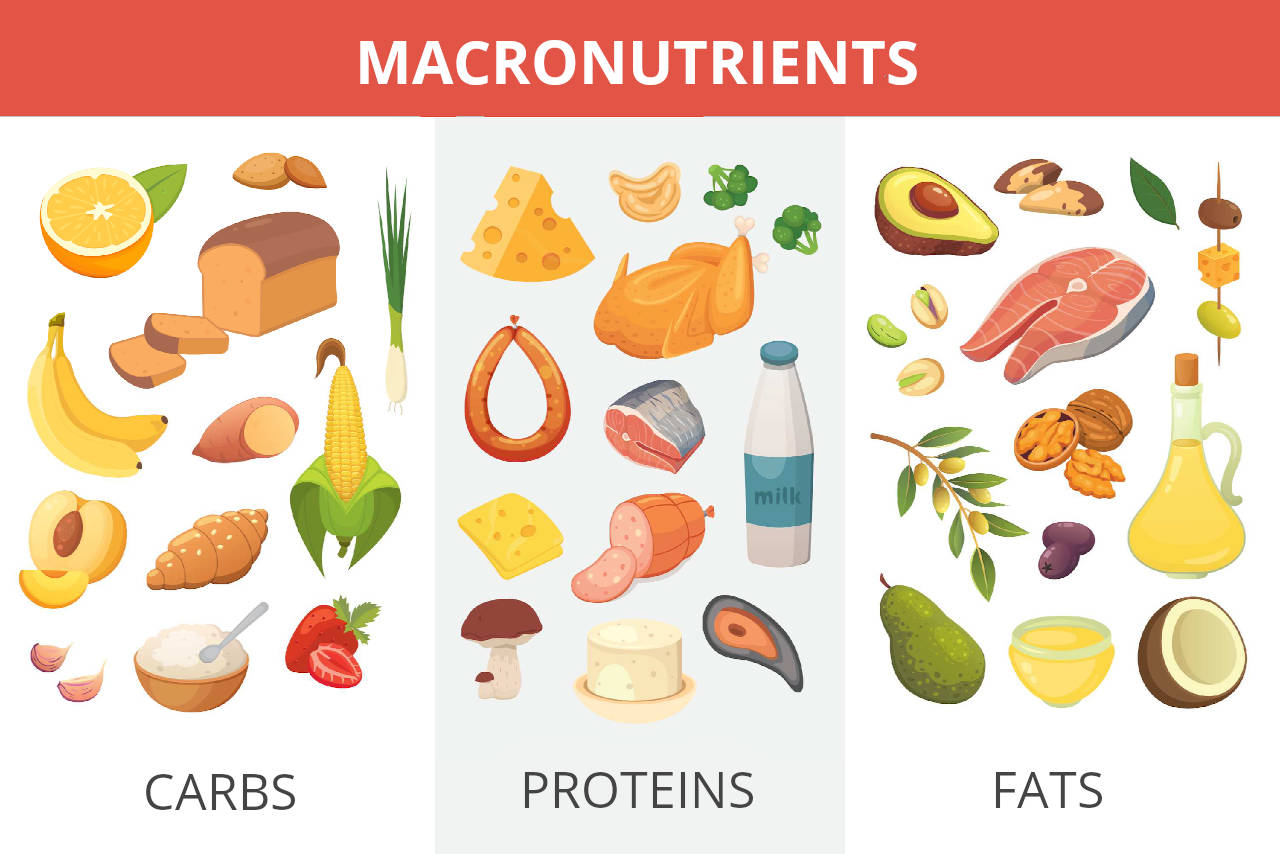Macro Calculator
Calculate the right macronutrient balance using our macro calculator below. Enter your age, gender, height, weight, and activity level to get started.
Your Macro Breakdown:
| Carbs: | ? grams/day
|
|---|---|
| Protein: | ? grams/day
|
| Fat: | ? grams/day
|
Daily Calorie Allowance
| Total: | ? kcal/day
|
|---|---|
| From Carbs: | ? kcal/day
|
| From Protein: | ? kcal/day
|
| From Fat: | ? kcal/day
|
On this page:
What Are Macronutrients
The food you consume every day is made up of macronutrients and micronutrients. Micronutrients are the vitamins and minerals that supplement your body to support your overall health, while macronutrients are the food components that supply your body with energy.
The three macronutrients, which are carbohydrates, protein, and fat, supply you with calories to provide fuel throughout the day.

A percentage of your calories comes from each of these three nutrient groups, and each macronutrient plays a specific role in your body’s functions. All supply energy (AKA calories); however, carbohydrates are the main energy source for exercise and activities.
Protein is the building block for muscle growth and maintenance, while fat is a vital component of cell membranes and also aids in the absorption of fat-soluble vitamins A, D, E, and K.
How To Calculate Macros
Deciding what proportion of your food should come from each macronutrient group depends on your fitness goals and health needs. This is often referred to as counting macros, or the diet “If It Fits Your Macros” (IIFYM).
Step One: Calculate TDEE
The first step is to determine how much energy your body uses every day. This is based on your total daily energy expenditure (TDEE), which you can calculate by multiplying your basal metabolic rate by your level of activity.
TDEE = BMR × Activity Factor
You can quickly calculate these using a TDEE and BMR calculator that takes into account your age, gender, height, and weight.
Step Two: Calculate Calorie Intake
Using your TDEE, you can determine how many calories you should eat each day to either maintain your current weight, lose weight, or gain muscle. Since your TDEE is your daily energy expenditure, if you consume this amount of calories, you should maintain your current weight.
To lose weight, you need to create a calorie deficit, and to gain muscle, you need to increase your calorie intake.
Step Three: Calculate Macro Breakdown
Once you calculate your desired calorie intake, you need to break this down into a proportion of each macronutrient.
Your health and fitness goals will be a guiding factor in determining what percentage of each macro your diet should consist of. For example, a bodybuilder will require a higher protein intake, while a marathon runner will more likely want to follow a diet higher in carbohydrates.
Athletes
For athletes competing in endurance events, carbohydrates are the predominant fuel for the working muscles. Therefore, this macronutrient needs to be readily available as a fuel source.[1]
Building Strength
On the other hand, if strength gains are your aim, research has shown that following a high protein diet in combination with a weight training program can improve body composition and increase lean muscle mass.[2]
Weight Loss
There are several ways to go about losing weight. Recently, ketogenic diets, or very low carbohydrate diets, have gained a lot of attention and are often used by individuals looking to lose weight. These diets are low in carbohydrates, moderate in protein, and high in fat and focus heavily on net carbs.
While there has been conflicting evidence, a recent meta-analysis from Reviews in Endocrine and Metabolic Disorders found that these diets were associated with weight loss along with reductions in waist circumference, body mass index, blood pressure, and cholesterol.[3]
However, these diets are not right for everybody, and it is best to discuss them with your dietitian or physician before starting this diet.
Use our keto calculator to find the optimal macro breakdowns for the keto diet.
When it comes to weight loss, everybody is different, and the most important thing to do is find the diet that is best for you.
Commonly Used Macro Splits
Whatever your health aims are, the IIFYM diet is an option for monitoring your calorie intake and ensuring you are consuming not just the right amount of overall calories but also that these calories are coming from the right sources.
Some common ways to break down your macros include:
| Goal | Protein | Carbohydrate | Fat |
|---|---|---|---|
| General Fitness/Balanced Macros[4] | 10-15% | 45-55% | 25-35% |
| Endurance Fitness/High Carb[4] | 20-30% | 55-65% | 30% |
| Low Fat Diet[5] | 35% | 45% | 20-30% |
| High Protein/BodyBuilding[6] | 25-30% | 55-60% | 15-20% |
| Special Diets: Ketogenic Diet[7] | 25% | 5% | 70% |
These are just a few examples, but you can customize your macros to create your own personalized plan. In addition, you can change your macro proportions from day to day, depending on your activity level.
For example, if you are doing a lot of endurance exercises one day, you might choose to increase your carb intake that day. If the next day is a rest day, you can switch over to a more balanced approach.
Counting macros can be an effective way to maintain a healthy eating pattern and can aid in weight loss and muscle building. You can target your specific needs by discussing your goals with a dietitian or physician to determine the best macro percentages for you to follow.
How to Count Macros
It is much easier to keep track of your macros by determining how many grams of each nutrient you should consume daily compared to a percentage of calorie amount.
Once you multiply your daily calorie needs by the percentage of each macro you intend to eat that day, you then need to divide that number by how many calories each macronutrient contains.
| Macronutrient | Calories per Gram |
|---|---|
| Fat | 9 kcal |
| Carbohydrate | 4 kcal |
| Protein | 4 kcal |
This will then give you how many grams of fat, carbohydrates, and protein you should consume to reach your goals.
How to Calculate Macros for Weight Loss
IIFYM can be an easy-to-follow approach that can be applied to any weight loss plan. You simply need to determine how many calories you should consume each day to create a safe caloric deficit that promotes weight loss.
You then apply the macro calculator to figure out how many grams of each macronutrient you should eat each day.
As a quick example, let’s say you are a moderately active, 6 foot 2 inch, 45-year-old male weighing 200 pounds.
Based on the TDEE calculator using the Mifflin St Jeor BMR formula, your total daily energy expenditure would be 2,866 calories. (BMR = 1,862 × 1.55 activity factor)
If you are trying to lose weight, you need to create a caloric deficit. As a starting point, you can decrease your daily calorie needs by 20%. In this case:
2,866 × 0.20 = 573 calorie deficit
2,866 – 573 = 2,293 calories to eat each day
You then multiply this by your macro percentages. Following a balanced macro diet, this would come out to the following proportions:
2,293 × 0.40 = 917.2 calories from carbohydrates
2,293 × 0.30 = 687.9 calories from protein
2,293 × 0.30 = 687.9 calories from fat
You then divide these numbers by the amount of calories each gram of the macronutrient provides as follows:
917.2 ÷ 4 = 229 grams of carbohydrates
687.9 ÷ 4 = 172 grams of protein
687.9 ÷ 9 = 76 grams of fat
Create a Calorie Deficit
Creating a caloric deficit with diet alone is one way to lose weight. However, combining this with increased physical activity has been found to improve and maintain weight loss compared with diet alone.[8]
For example, a 2018 study from the Journal of the American Medical Association found that individuals following either a healthy low-fat diet versus a healthy low-carbohydrate diet lost a similar amount of weight.[9]
It’s about personalizing your diet to your specific health needs, and choosing a diet that you can actually adhere to for the long term.
Counting Macros For A Healthy Lifestyle
Counting macros is a straightforward way to target any fitness goal, whether that be losing weight, building muscle, or maintaining a healthy lifestyle.
Once you determine how many grams of each macro you need to consume on a daily basis, you can then divide this up into your meals and snacks to create a nutritious diet plan.

References
- Hawley, J. A., & Leckey, J. J., Carbohydrate dependence during prolonged, intense endurance exercise, Sports Medicine, 2015, 45(1), 5-12. https://link.springer.com/content/pdf/10.1007/s40279-015-0400-1.pdf
- Antonio, J., Ellerbroek, A., Silver, T., Orris, S., Scheiner, M., Gonzalez, A., & Peacock, C. A., A high protein diet (3.4 g/kg/d) combined with a heavy resistance training program improves body composition in healthy trained men and women–a follow-up investigation, Journal of the International Society of Sports Nutrition, 2015, 12(1), 1-9. https://jissn.biomedcentral.com/articles/10.1186/s12970-015-0100-0
- Castellana, M., Conte, E., Cignarelli, A., Perrini, S., Giustina, A., Giovanella, L., et al., Efficacy and safety of very low calorie ketogenic diet (VLCKD) in patients with overweight and obesity: A systematic review and meta-analysis, Reviews in Endocrine and Metabolic Disorders, 2020, 21(1), 5-16. https://link.springer.com/article/10.1007/s11154-019-09514-y
- Bachus, T., How to Determine the Best Macronutrient Ratio for Your Goals, American Council on Exercise, 2016, April 15, https://www.acefitness.org/resources/pros/expert-articles/5904/how-to-determine-the-best-macronutrient-ratio-for-your-goals/
- Aragon, A. A., Schoenfeld, B. J., Wildman, R., Kleiner, S., VanDusseldorp, T., Taylor, L., Earnest, C. P., Arciero, P. J., Wilborn, C., Kalman, D. S., Stout, J. R., Willoughby, D. S., Campbell, B., Arent, S. M., Bannock, L., Smith-Ryan, A. E., & Antonio, J., Journal of the International Society of Sports Nutrition, 14(1), https://doi.org/10.1186/s12970-017-0174-y
- Lambert, C. P., Frank, L. L., & Evans, W. J., Macronutrient considerations for the sport of bodybuilding, Sports Medicine (Auckland, N.Z.), 2004, 34(5), 317–327. https://doi.org/10.2165/00007256-200434050-00004
- Zhu, H., Bi, D., Zhang, Y., Kong, C., Du, J., Wu, X., Wei, Q., & Qin, H., Ketogenic diet for human diseases: the underlying mechanisms and potential for clinical implementations, Signal Transduction and Targeted Therapy, 2022, 7(1), https://doi.org/10.1038/s41392-021-00831-w
- Catenacci, V. A., & Wyatt, H. R., The role of physical activity in producing and maintaining weight loss, Nature Clinical Practice Endocrinology & Metabolism, 2007, 3(7), 518-529. https://www.nature.com/articles/ncpendmet0554
- Gardner CD, Trepanowski JF, Del Gobbo LC, et al., Effect of low-fat vs low-carbohydrate diet on 12-month weight loss in overweight adults and the association with genotype pattern or insulin secretion: the DIETFITS randomized clinical trial, Jama, 2018, 319(7), 667-679. https://jamanetwork.com/journals/jama/fullarticle/2673150



